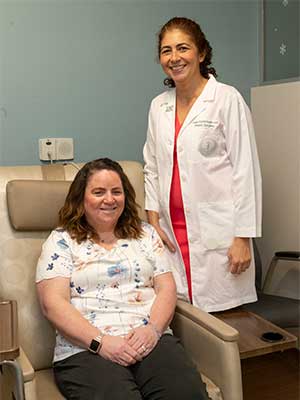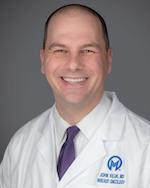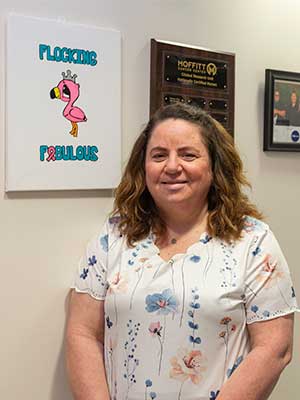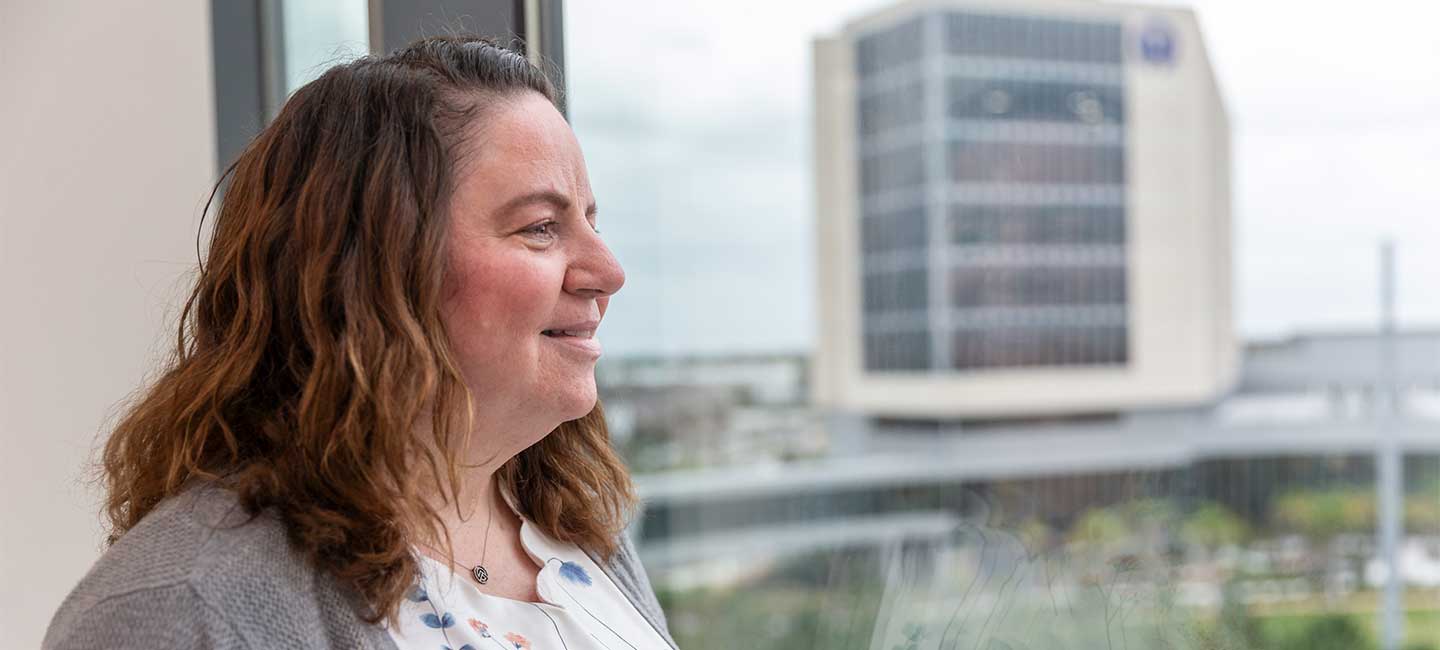Reconstruction Surgery Helps Some Patients Regain a Sense of Normalcy
Angela Stout remembers her first thought when she awoke from breast reconstruction surgery at Moffitt Cancer Center.
“I looked down, and I was very excited that there were two again!” she said.
For 12 months, Stout had lived as “half flat,” as she calls it.
In May 2021, Stout had a mastectomy on her right breast at Moffitt after she was diagnosed with invasive ductal carcinoma, HER2-positive breast cancer. Afterward, she underwent 25 rounds of targeted radiation therapy, so reconstruction had to wait.
“I lived that way for a whole year, and it played with my whole mental focus,” Stout said. “Looking in a mirror for a year and seeing only one breast and the scars where my right breast used to be impacts how you feel about yourself. I don’t know if the other breast had been taken right away if that would have changed things or not.”
After completing months of radiation, though, she had a choice.
“My doctors talked to me about a mastectomy to remove the noncancerous left breast because of my family history,” Stout said. “Even with a breast prosthetic, I still felt uneven and felt everyone could see it.”
Stout said it even impacted her self-esteem around her husband, to the point that she would avoid letting him see her without a top on. “And I’d avoid looking at myself in the mirror,” she said.
That’s a common feeling among patients, reconstructive surgeon Deniz Dayicioglu, MD, explains. Many patients find that reconstruction improves their well-being.
“A mastectomy is an emotional scar, and a lot of healing takes place, not just surgical but psychological,” Dayicioglu said. “Some patients feel fine without any reconstruction and are happy to be done with surgeries. Everyone is different, and that’s OK.”
An Immediate Continuation of Care
In Stout’s case, Dayicioglu supported her choice to have breast reconstruction. Her second surgery would involve removing her left breast and then undergoing full reconstruction on both breasts. This would all be done in one eight-hour surgery, which would make recovery easier.
Stout, a resident of Plant City, Florida, is among a growing number of breast cancer patients who have had both treatment and reconstruction surgery done at Moffitt. For Stout, having reconstruction done in the same building where she underwent treatment made sense.
“I am beyond thankful that I was able to receive continuation of care from start to finish at Moffitt,” the 46-year-old said. “I have an amazing oncology team, and knowing how connected my team was when it came to my transition of care from one phase of my treatment to the next was important to me.”

Stout's reconstructive surgeon, Deniz Dayicioglu, MD, performed a type of procedure that uses a section of abdominal skin and fat, along with blood vessels, to re-create breasts.
Stout’s surgical oncologist, Nazanin Khakpour, MD, who performed her original mastectomy, returned to the operating room in May 2022 and removed her remaining left breast. Dayicioglu and her team then stepped in and performed a deep inferior epigastric perforator flap procedure (DIEP flap) to re-create both breasts.
In this type of surgery, a section of abdominal skin and fat, along with blood vessels, is removed and attached to the chest to create a breast through microsurgical techniques.
“Breasts can be reconstructed in many ways, mostly with implants,” Dayicioglu said. “But in Angela’s case we were able to remove fatty tissue off the body, save the muscles, reconstruct the breasts and get a slim stomach at the same time.”
Less than 10% of breast reconstruction patients are eligible for this specific procedure, which takes longer than implants and requires a longer recovery period. It’s especially useful in patients like Stout, who had undergone radiation as part of her cancer treatment.
“Tissue changes with radiation,” Dayicioglu said. “We see more scarring around an implant when there is radiation, and in the long-term this population of patients experiences asymmetries. Due to those reasons, using a patient’s own tissue like in a DIEP flap is a better choice in the right candidates.”
When Stout first heard of this procedure, she started researching it online and even joined Facebook groups for women who had either undergone the surgery or were considering it. She was happy to learn she was a candidate for this type of reconstruction.
“Waking up and realizing that I had two breasts again brought tears of joy,” Stout said. “I felt normal again even though I was still healing.”
Renconstruction Goes Beyond Breast Patients
John Kiluk, MD, leader of the Reconstructive Oncology Program at Moffitt, says that having plastic surgeons like Dayicioglu on site at Moffitt allows surgeries to proceed that would be much more challenging elsewhere.
“At Moffitt, we see some of the toughest cancers in the state,” Kiluk said. “Having plastic surgery expertise like we have here really allows us to do resections that we otherwise couldn’t do. The plastic surgery team can come in following a resection and help us close the wound.”
Plastic surgery, he added, helps in so many different aspects of patient care, including minimizing the emotional trauma of losing a breast or decreasing the risk of lymphedema.
“Our plastic surgeons are experts at improving quality of life,” Kiluk said.

Rogerio Neves, MD, PhD, a plastic surgeon and senior member in the Department of Cutaneous Oncology at Moffitt, notes that the plastic surgery team is involved in all types of procedures outside of breast reconstruction, as well. The team works closely with surgical oncologists in many departments across Moffitt.
“Skin cancers often require many surgeries, and depending on the size and location of that procedure, plastic surgeons may be called in to minimize any deformity,” he said. “Often, at a later time, after surgery or radiation therapy, a reconstructive procedure may be scheduled to restore a patient’s function and appearance as much as possible.”
Head and neck, gynecologic, sarcoma, gastrointestinal, genitourinary, neuro and cutaneous oncology surgeons may also call on a reconstructive surgeon to assist in a patient’s treatment, Neves said.
Currently, Moffitt utilizes the talents of 10 plastic surgeons across multiple disciplines to improve patient outcomes.
“These surgeons are an amazing asset to our institution and to our patients,” Kiluk said. “Together, we are able to minimize the impact of cancer on our patient’s lives. ”
A Personal Decision
For Stout, the decision to undergo reconstruction surgery after her mastectomies was very personal. She realizes it’s not a decision every woman makes.
“I think there’s a preconception that reconstruction is tied with vanity,” Stout said. “I’m thrilled with the results from the reconstruction, and I’m very happy with my appearance. It has also helped me heal emotionally and psychologically. I no longer avoid looking in the mirror, and I have learned to love my body again.”
Dayicioglu agrees that reconstruction ultimately depends on the patient’s preference. The goal, she said, is for a patient to be happy, comfortable and satisfied with treatment following cancer.
“For us, as long as the patient is satisfied with the results, we’re happy,” she said. “If they have any doubt or are looking for a correction, we can discuss it and look at options.”
Patients who have had reconstruction may want to come back and fine-tune some things, Dayicioglu said, adding that there is always room for revision. Those follow-up procedures are much simpler and take 30 minutes or so compared to the more in-depth reconstruction that Stout experienced.
Stout has returned to Dayicioglu to have some scar revisions and grafting done to establish a more symmetric look, for example. In February 2023, Stout visited Dayicioglu again to construct nipples on her new breasts.
Although she originally considered tattoos to re-create her nipples, Stout ultimately decided reconstructing her nipples would help her reclaim even more of her femininity.
“I had breasts again,” she said. “But without nipples, it just felt strange.”
Being a Reconstruction Advocate
Today, Stout shows “no evidence of disease,” meaning there is no sign of cancer in her body.
Since she was first diagnosed, Stout has been active on social media and has connected with other women who have undergone a variety of breast cancer treatments. She even created her own Facebook page called “Angela’s Journey: Kicking Breast Cancer’s Butt” to share and document her cancer story.
In another group, she and other women share their reconstructive journeys following mastectomies and even compare notes and photos about their experiences.

Stout's painting of a flamingo hangs as inspiration at Moffitt's McKinley Campus.
“I’m part of a DIEP flap support group on Facebook, and we encourage each other and talk about our doctors and our journeys,” Stout said. “I use that platform to share different resources, take what I learn from these women and share with others in different groups. It’s all about supporting each other, complimenting each other and showing that no one is alone, no matter what they decide in their treatment.”
Stout’s experience at Moffitt has also triggered her creative side. She has counted 227 appointments at Moffitt since her diagnosis. During that time, she has collected inspirational T-shirts and other items that reflect positivity and humor, encouraging anyone who is on a cancer journey.
She even created a piece of art in honor of her Clinical Research Unit team at Moffitt’s McKinley Campus to mark the end of her active treatment in January 2022. In that painting, a flamingo poses near the words “Flocking Fabulous.” She also has another favorite design: a skeleton that says, “Check your boobs, mine tried to kill me.”
“You have to use humor and turn bad news into a positive attitude when you can,” Stout said.
Talking about reconstruction, or breasts in general, can be uncomfortable for a lot of people. But Stout encourages women to embrace the journey and look at all the options available to them.
While she’ll continue to be monitored following her treatment at Moffitt, an experience she says she’s happy to continue, she is relieved that she will get to avoid one uncomfortable experience.
“I have my breasts, but I don’t have any breast tissue,” she said. “So no more mammograms for me.”
This story originally appeared in Moffitt's Momentum magazine.



